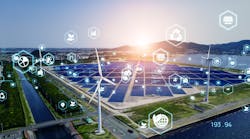We’re currently witnessing the largest transformation the U.S. electrical grid has seen for more than a century. This year, more than 60% of new utility-scale generation in America will be renewable while energy storage capacity on the same scale is expected to grow 84% (Source: U.S. Energy Information Administration (IEA), January 2022). At the same time, electrification of buildings and transport is challenging our grid to provide more electrical capacity than ever before.
As energy needs increase and the grid becomes more dynamic and complex, new tools are essential to help our distribution network manage the challenges of the future. This need for reliable, resilient and cybersecure energy is the driving force behind our nation’s current US$ 29 billion infrastructure investment.
Three foundational capabilities making the smart grid a reality
As the grid topology changes, flexible load management is a keystone that can be used to accelerate grid optimization — helping utilities create flexible energy systems through the ability to predict, prepare and manage ever-changing energy systems and needs.
1. Incident isolation is increasing power availability despite accelerating weather events.
Every year, extreme weather and natural disasters reach new extremes, causing more service interruptions and safety concerns for the utility workers who need to repair or replace equipment.
Intelligent equipment is helping reduce interruption frequency and duration by automatically and remotely isolating and managing faults. For example, modern recloser technology can respond to fault conditions faster, automatically reconfiguring energy flow, minimizing the impact of a power outage and improving electric grid availability.
2. Sophisticated modeling and planning simplify the quick integration of renewables and planning for capacity requirements.
Can adding a battery system, for example, help defer or avoid costly grid upgrades for a community? Highly complex engineering analysis is required to determine where and if distributed energy resources (DERs) can be added.
While engineering resources are in short supply and high demand, sophisticated software is available that automates complex engineering analyses to deliver the knowledge needed to support DER integration projects. Novel digital tools are helping inform decisions and close the gap between regulatory pressures to decarbonize energy systems and making it happen. And new analytics provide greater insights into grid potential and performance. These capabilities empower utilities to quickly and accurately identify optimal approaches to integrate renewables, add storage and expand energy efficiency programs.
3. Real-time response to grid conditions is improving reliability as more variability is introduced.
With more renewables coming online, stabilizing grid voltage takes more effort. And as we start to rely on the grid to energize more of our vehicles, homes and buildings, addressing grid efficiency and stability is increasingly important.
Through a combination of proven equipment, software and services, utilities can optimize the grid for more dynamic conditions. For example, Volt/VAR control software can help manage power factor and power quality. Plus, it supports conservation voltage reduction (CVR), a voltage reduction strategy that reduces demand and energy usage, so a greater percentage of energy is delivered to utility customers, while helping to defer new generation capacity additions and reducing carbon footprint. This means power can be delivered more efficiently at a higher quality and lower cost.
Moving towards new energy frontiers
For more than a century, power has flowed in one direction — from large, centralized power plants to utility customers. That’s no longer true. Today, there’s an enormous opportunity to transform the distribution network to support an increasingly electrified world with far more distributed generation.
We know the distribution network will need to work harder and do more to power a sustainable, resilient future. Despite weather events, the power needs to stay on. As our world electrifies, we’re going to reach new peak requirements and energize them. And rather than simply managing energy supply to meet the growing need for energy, new grid intelligence will help balance supply and demand.
Utilities are currently making massive changes to help the world realize a low-carbon future. And this transformation can be simplified and accelerated with creative solutions that reduce interruption frequency and duration, drive operational efficiency and manage a fragmented distribution system — creating the foundation for a smarter electrical grid.
Jon Wehrli is Retired President, Power Systems Division, at Eaton.


